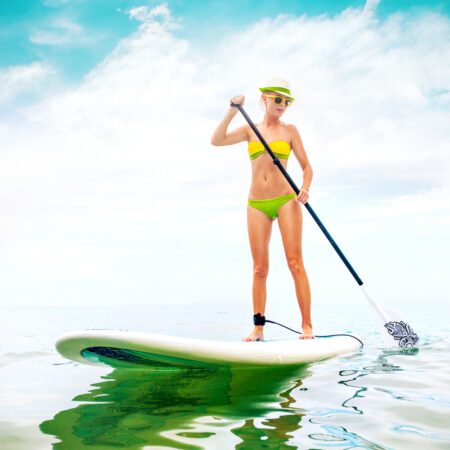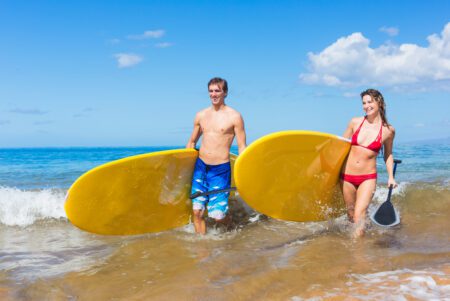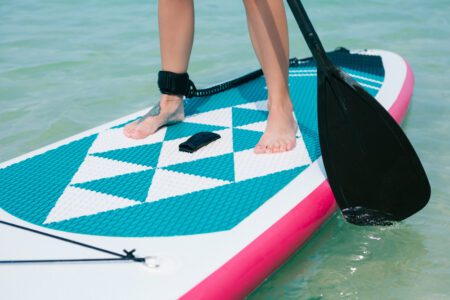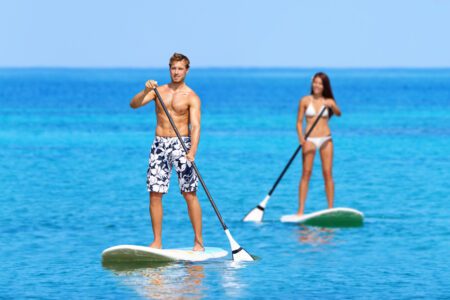 This article answers the questions what is stand-up paddle boarding and how hard is stand-up paddle boarding.
This article answers the questions what is stand-up paddle boarding and how hard is stand-up paddle boarding.
It discusses the activity’s benefits and downsides and how to start stand-up paddle boarding. Additionally, it contains tips on equipment requirements, choosing a board for beginners, and more.
Stand-up paddle boarding (SUP) is a water sport in which the participant stands on a large, stable board and uses a paddle to propel themselves through the water.
It is believed to have originated in Hawaii, where it was used as a means of transportation.
Nowadays, it is a popular recreational activity enjoyed by millions of people of all ages worldwide.
Stand-up paddle boarding suits various environments, including oceans, rivers, lakes, and canals.
It can be done for leisure or as a high-intensity workout, depending on how hard you paddle.
This versatility means you can exercise or just have fun on the water while enjoying the great outdoors.
Table of Contents
How hard is stand-up paddle boarding?
After learning what’s involved, people often ask how hard is stand-up paddle boarding and if anyone can do it.
The good news is it can be enjoyed by people of almost any age and fitness level. Unlike some sports, it can be as easy or challenging as you make it.
Beginners may take some time to get the hang of balancing on the board and using the paddle effectively. However, with practice and proper technique, it becomes easier and more enjoyable.
The level of difficulty can also depend on the water conditions, wind factor, and how much effort you exert.
Paddling in calm, flat water will be easier than paddling in rough or choppy water.
Similarly, leisurely paddling at a low intensity will be easier than paddling at a high intensity for a workout.
Next, we will look at the benefits of stand-up paddle boarding and the potential drawbacks.
Benefits of Stand-Up Paddle Boarding
When undertaken regularly, stand-up paddle boarding offers numerous physical and mental benefits, including the following: 
Low impact –
SUP is a low-impact activity that doesn’t stress the joints
Provides a full-body workout –
It provides a total-body workout, toning the shoulders, back, core, torso, arms, and legs
Aids weight loss –
Stand-up paddle boarding can burn between 305 and 430 calories per hour, depending on factors such as your gender, weight, effort exerted, and the water and wind conditions
Helps improve balance, strength, and endurance –
Regular workouts will hone your balance, strength, and endurance, improving your appearance, sense of well-being, and functional fitness
Increases flexibility and mobility –
Over time, paddleboarding will improve your range of motion
May relieve stress –
Being on the water can be a great way to relax and de-stress
Improves heart health –
When done at moderate to high intensity, paddle boarding offers excellent cardiovascular benefits
Provides an opportunity for socialization –
It is an ideal activity to do with friends and family, enabling you to bond as you have fun
Enables access to beautiful locations –
Stand-up paddle boarding can take you to beautiful locations that may be difficult to access by land, enabling you to explore and appreciate the wonders of nature from a unique perspective.
Potential Drawbacks of Stand-Up Paddle Boarding
Can be physically demanding –
Paddle boarding at a high intensity or in rough water and weather conditions can be physically taxing at the time, and your muscles will feel it the next day
Injury risk –
As with any sport, this one comes with an injury risk – you could fall off your board or collide with people or objects in the water and potentially drown
Can be cumbersome –
Depending on your strength and transport mode, boards can be heavy and awkward to lug around if they aren’t inflatable
Accessibility limitations –
To do stand-up paddle boarding, you will need access to suitable bodies of water
Environmental impact –
Stand-up paddle boarding can negatively impact the environment if undertaken irresponsibly
Cost –
Boards and accessories can be expensive, especially if you buy high-quality gear
Next, we will take a quick look at how to start stand-up paddle boarding for those interested in trying it.
Stand Up Paddleboarding Video
You may also like to check out this excellent video tutorial I found on YouTube.
How to Start Stand-Up Paddle Boarding
Here are some tips for beginners wanting to start stand-up paddle boarding:
Learn the basic techniques –
Start by learning basic techniques, such as standing on the board, paddling, and turning.
You can find instructional videos online or consider taking a lesson from a certified instructor.
Choose the right equipment –
The first thing you will need is a stand-up paddle board.
You will also need a paddle and an ankle leash. The leash will keep you connected to the board and enable you to pull it toward you, making it easier to climb back on if you fall off.
You will need a fin or fins for tracking (moving forward in a straight line) and a personal flotation device (PFD) to help keep you safe.
If using an inflatable model, you will need a pump.
A whistle will enable you to alert others who can’t see you to your presence, and you will need a flashlight if you go out after dark.
Consider renting the main items initially to see if stand-up paddle boarding is something you enjoy and will contnue to pursue before making a significant investment.
If you are ready to purchase a board, as I did recently, I recommend the DAMA Inflatable Stand-Up Paddle Board. Its budget-friendly and comes with everything you need for SUP adventures.
Clothing and Footwear –
Your clothing and footwear requirements will vary depending on the outside and water temperatures. Be aware that these can vary significantly. Hypothermia can set in quickly, so wear clothing suited to the water temperature.
Regardless of the temperature, choose attire made of quick-drying fabric so you will be more comfortable if you fall into the water or it rains.
Nylon, spandex, Lycra, and polypropylene are good choices, as is neoprene.
When the temperature is high, and the sun is out, board shorts or a swimsuit, a sun-protective shirt, and a sun hat are ideal.
Most people paddle barefoot. Neoprene shoes or booties are useful when it’s cold, or you need to walk over jagged rocks to get to the water.
A form-fitting neoprene top and shorts are good cold-weather choices. The snug fit will provide better insulation and cut wind drag.
You can wear a wet suit for extra insulation, but keep in mind that when paddling for exercise, not leisure, your body will work harder so you won’t feel as cold.
If it’s really cold, consider paddling gloves, socks, and a hat made from wool or synthetic fiber.
Other essentials –
Wear sunscreen to protect your skin from the sun’s harmful UV rays, a lip balm to protect your lips, and sunglasses to cut glare.
Take bottled water.
A towel will also come in handy.
Find a suitable location –
Look for a calm body of water free of obstacles, such as swimmers, rocks, boats, and other watercraft.
Avoid strong currents and high winds, and check the weather forecast before heading out.
Staying safe –
We should all learn to swim, and this is even more important when doing water sports.
Even if you’re an excellent swimmer, always wear a PFD when stand-up paddle boarding, and be aware of your surroundings.
There’s safety in numbers, so beginners should not paddle alone.
Stay away from boats and other objects, and be prepared for unexpected weather and water condition changes.
Take a safety whistle and use it if you see a boat heading your way and don’t think the occupants can see you. You can also use the whistle to attract attention in an emergency.
The following tips should help you master stand-up paddle boarding faster.
Mounting Your Stand-Up Paddle Board and Standing
- Stand beside your board in calm water deep enough that the fins aren’t touching the bottom.

- Place your paddle across the board, just behind its carry handle.
- Grasp the board’s edges or the paddle firmly to stabilize it, then carefully lift your knees onto the center of the board, one at a time, behind the paddle.
- Still holding the board and with your knees still bent, place one foot, then the other, flat on the board.
- Keep your paddle in the water to help stabilize yourself, lift your chest and push yourself up, straightening your legs to stand.
Balancing
- Position your feet towards the center of the board so they are parallel and approximately hip distance apart. Your head should be up, your back straight, your knees slightly bent, and your toes pointing forward.
- Move your hips and torso to help maintain your balance.
- Focus on an object that is straight ahead, and avoid hunching over or looking down at your feet.
Paddling
- When paddling, your board’s blade should angle forward from the shaft toward the board’s nose.
- When paddling on your board’s right side, your left hand should be on its T-grip and your right hand a few feet down the shaft. When paddling to the left of the board, reverse the position of your hands.
Falling and getting back on your board
Everyone falls into the water at times, especially beginners. It’s no big deal, but knowing how to fall can help prevent an injury.
When you feel you are about to fall, push your body sideways to prevent hitting the board.
(Try and keep a grip on your paddle. If it drops into the water, get on your board, and propel yourself with your hands to retrieve it.)
To remount the board, position yourself beside its center.
Grasp the carry handle with one hand, float your legs up and out behind you, kicking them as you pull on the handle and slide onto the board.
The Strokes
When stand-up paddle boarding, you will need to master the following three strokes:
The Forward or Basic stroke to move forward.
The Reverse stroke to move backward.
The Sweep stroke to turn.
Two other strokes worth learning are the Draw stroke, which is useful if you want to pull up beside a stationary object such as a dock, and the Cross Bow stroke, which is handy for quickly changing course while paddling.
The REI website has an excellent SUP article that includes instructions for the above strokes. You can access it by clicking this link.
Stand-Up Paddle Boarding Tips for Beginners
Stand on your board with relaxed knees. 
Don’t stand too far forward.
Focusing on an object ahead of you will make it easier to keep your balance.
Maintaining constant momentum will make balancing easier.
Your first outings should be in calm water that is free of obstacles.
Choose a day when the water is calm, and it’s not windy. If there’s a slight breeze, use it to your advantage by setting off into it. Providing the breeze doesn’t change direction, it will help push you along on the return trip when you will probably be feeling tired.
Don’t stay out too long in the beginning. Thirty to sixty minutes is fine.
Only go out alone once you have some experience under your belt.
What is the best beginner stand-up paddle board?
When selecting a beginner stand-up paddle board, look for one that is stable, buoyant, easy to handle, and suitable for your intended use.
With this in mind, here are some factors to consider:
Length –
A longer and broader board will generally be more stable and easier to handle than a shorter and narrower one.
Look for a board at least 10 feet long and 30 inches wide.
Thickness –
A thicker board will be more stable in the water, but it will also be heavier and more difficult to carry.
Choose a board that is at least 4 inches thick.
Construction –
Stand-up paddle boards are typically foam, inflatable, or rigid plastic.
Foam boards are the most stable and durable but also the heaviest.
Inflatable boards are lighter and easier to transport, but less stable and not always as durable.
Hard plastic boards are a good compromise but can be more expensive.
Intended use –
The best beginner stand-up paddle board for you will depend on your specific needs and personal preference.
Some boards are designed specifically for surfing, touring, racing, yoga, or fishing. In contrast, others are more versatile, so consider the type of water you will be paddling in and the activities you plan to do.
Final Thoughts on Stand-Up Paddle Boarding
With a bit of practice and the right equipment, almost anyone can enjoy stand-up paddle boarding as a fun and healthy outdoor activity that may enable you to discover places you didn’t know existed.
Depending on the conditions and your aim, it can be challenging or a meditative and peaceful activity that allows you to clear your mind and focus on the present moment.
As well as assisting with weight loss and toning your body from shoulders to calves, regular stand-up paddle boarding sessions can improve your cardiovascular health, balance, strength, endurance, flexibility, and mobility.
Be mindful of your safety by dressing to suit the conditions, wearing sunscreen and a PFD and taking a whistle with you, and there’s no reason you won’t love SUP as much as its myriad of fans.
If you love the water but want to start with something less adventurous, check out my article containing 10 pool noodle exercises.
You may also like this article on the benefits and downsides of swimming as exercise.

